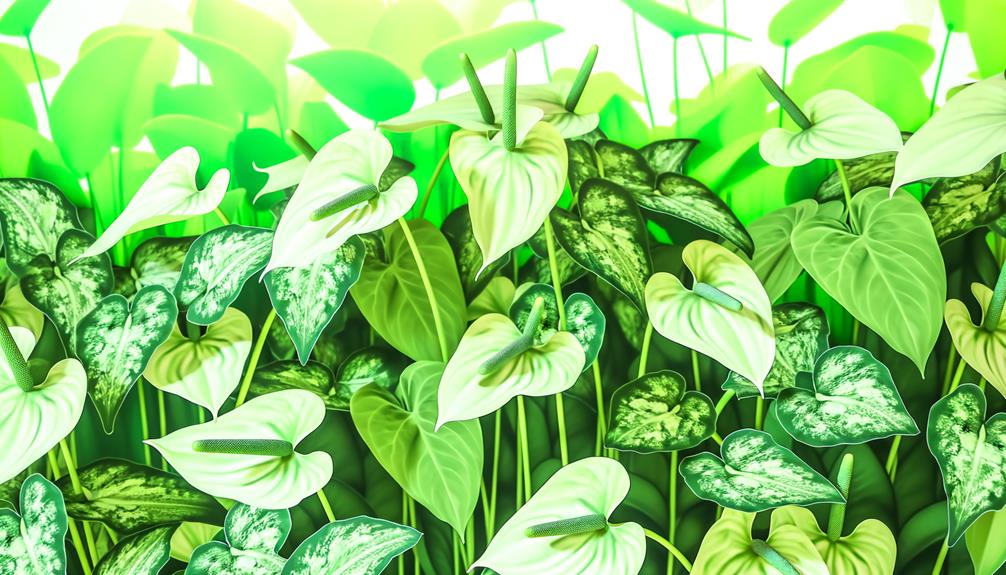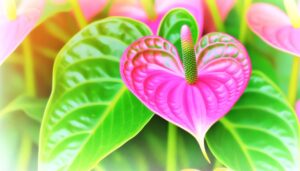Why Are My Anthurium Flowers Not Turning Red?
Anthurium flowers not turning red often stem from insufficient light, as they require 1,500 to 2,500 foot-candles for best pigment production. Incorrect watering, whether overwatering leading to root rot or underwatering causing dehydration, disrupts nutrient uptake essential for red pigmentation.
Humidity levels below 70-80% can impair stomatal function, affecting anthocyanin synthesis. Temperature extremes and poor soil quality, including nutrient deficiencies in phosphorus and potassium, also hinder vibrant coloration.
Additionally, genetic factors and aging flowers contribute to pigment degradation. For more thorough strategies to rectify these issues, continue exploring the detailed aspects of Anthurium care.

Key Takeaways
- Insufficient light intensity impedes anthocyanin biosynthesis, preventing red pigmentation in Anthurium flowers.
- Inadequate watering schedules affect nutrient uptake, essential for vibrant red coloration.
- Nutrient deficiencies, particularly in phosphorus, potassium, and iron, inhibit anthocyanin production.
- Poor soil quality and improper pH levels disrupt anthocyanin synthesis and flower coloration.
- Extreme temperatures and inconsistent humidity levels stress the plant, affecting pigment development.
Insufficient Light
Insufficient light is a primary factor contributing to the failure of Anthurium flowers to develop their characteristic red pigmentation, as these plants require sufficient light intensity to drive the photosynthetic processes essential for anthocyanin synthesis.
Anthocyanins, the pigments responsible for the red coloration, are synthesized through a light-dependent pathway. Research indicates that subpar light conditions impede chlorophyll activity, thereby reducing the energy available for pigment production.
Ideal light levels range between 1,500 to 2,500 foot-candles, ensuring the activation of the photoreceptors necessary for anthocyanin biosynthesis. Additionally, spectral quality of light, particularly blue and red wavelengths, plays a vital role in facilitating this process.
Hence, maintaining appropriate light intensity and quality is essential for achieving the desired red hue in Anthurium flowers.
Incorrect Watering
Incorrect watering practices can greatly impact the pigmentation of Anthurium flowers. Overwatering can lead to root rot and nutrient deficiencies, while underwatering can cause dehydration and stress, both of which hinder proper coloration.
Establishing a precise watering schedule that maintains ideal soil moisture levels is essential for achieving the desired red hue in Anthurium blooms.
Overwatering Issues
Excessive water can lead to root rot in Anthurium plants, substantially impairing their ability to absorb essential nutrients and thereby preventing the flowers from turning red. Root rot occurs when waterlogged conditions promote the proliferation of pathogenic fungi, which degrade root tissues. This pathological state hinders nutrient uptake, specifically nitrogen and magnesium, fundamental for anthocyanin synthesis—the pigment responsible for red coloration. Below is a detailed breakdown of overwatering effects:
| Factor | Impact on Plant | Consequence for Flowers |
|---|---|---|
| Excessive Water | Root Rot | Nutrient Deficiency |
| Pathogenic Fungi | Degradation of Root Tissues | Impaired Nutrient Absorption |
| Nutrient Deficiency | Reduced Anthocyanin Synthesis | Flowers Not Turning Red |
| Soil Aeration Decrease | Oxygen Availability Reduction | Stunted Plant Growth |
Understanding these interactions is essential for diagnosing and remedying overwatering issues in Anthuriums.
Underwatering Consequences
Dehydration in Anthurium plants, resulting from inadequate watering practices, can severely limit the uptake of essential nutrients necessary for vibrant red flower pigmentation. Insufficient hydration can impair root function, reducing the plant's ability to absorb key minerals such as magnesium and phosphorus, which are essential for chlorophyll production and overall metabolic processes.
As a result, the biochemical pathways responsible for anthocyanin synthesis—the pigments that render flowers their vivid red hue—are disrupted. Empirical studies indicate that water stress triggers stomatal closure, diminishing transpiration rates and nutrient transport. This physiological response further compromises cellular turgor pressure, leading to suboptimal flower development.
Understanding the intricate relationship between hydration levels and nutrient availability is vital for the cultivation of healthy, vividly colored Anthurium flowers.
Proper Watering Schedule
To mitigate the adverse effects of dehydration, establishing a precise and consistent watering schedule is essential for maintaining ideal nutrient uptake and ensuring the development of vibrant red Anthurium flowers.
Anthuriums require a well-regulated hydration regime to avoid the physiological stress associated with water deficits or excesses. Evidence indicates that inconsistent watering disrupts nutrient absorption, especially calcium and magnesium, crucial for the pigmentation process.
A detailed analysis reveals that the substrate should remain uniformly moist but not waterlogged. Employing a moisture meter can provide accurate readings, preventing both under- and over-watering. Additionally, utilizing well-draining potting mixes enhances aeration and root health.
Adhering to this regimen promotes not only optimal growth but also the desired chromatic development in Anthurium flowers.
Inadequate Humidity
Best humidity levels for Anthurium plants range between 70-80%, which are essential for maintaining their vibrant red coloration. Evidence indicates that less than ideal humidity can lead to stress, resulting in pale or greenish flowers.
Implementing humidity-boosting techniques, such as using humidifiers or pebble trays, can greatly enhance the environmental conditions, promoting healthier and more colorful blooms.
Optimal Humidity Levels
Insufficient ambient moisture can impede the Anthurium's ability to develop its characteristic red pigmentation, as these plants thrive in environments with consistently high humidity levels. Best humidity for Anthuriums ranges between 70-80%, a threshold necessary to maintain cellular turgidity and metabolic functions essential for anthocyanin synthesis—the pigment responsible for the red coloration.
Research indicates that subpar humidity can lead to physiological stress, showing in color loss and reduced flower quality. Additionally, inadequate humidity disrupts stomatal function, diminishing transpiration rates and nutrient uptake.
Ensuring an environment that mimics the Anthurium's natural tropical habitat is vital for promoting vibrant flower coloration and overall plant health. Understanding and maintaining these conditions is pivotal for horticulturists aiming to achieve prime floral aesthetics.
Humidity-Boosting Techniques
Addressing the challenge of maintaining high humidity levels for Anthuriums is crucial for proper anthocyanin synthesis and best flower pigmentation. Utilizing a humidifier can greatly increase ambient moisture, achieving ideal levels between 70-80%.
Additionally, implementing pebble trays filled with water beneath the plants can enhance localized humidity through evaporation. Grouping plants together also creates a microenvironment that retains moisture.
Regular misting may temporarily boost humidity but tends to be less efficient long-term. Empirical studies underscore the importance of consistent humidity for optimal anthocyanin production, the pigment responsible for the red coloration in Anthurium flowers.
Hence, integrating these techniques is vital for maintaining the vibrant red hue characteristic of healthy Anthurium blooms.
Poor Soil Quality
Poor soil quality significantly affects the coloration of Anthurium flowers, as less than ideal nutrient availability can impede the plant's ability to produce the vibrant pigments necessary for red blooms. Vital macro and micronutrients such as nitrogen, phosphorus, potassium, and iron are crucial for anthocyanin synthesis, the pigment responsible for red coloration. Soil pH also plays a significant role; excessively acidic or alkaline conditions can hinder nutrient absorption, resulting in dull or greenish flowers.
| Soil Issue | Impact on Anthurium | Emotional Response |
|---|---|---|
| Nutrient Deficiency | Faded color | Concern |
| Improper pH | Poor pigment production | Frustration |
| Compacted Soil | Reduced root health | Worry |
| Poor Drainage | Root rot risk | Anxiety |
Regular soil testing and amendments are essential to ensure ideal growth conditions.
Temperature Issues
In addition to soil quality, temperature fluctuations can also greatly impact the pigmentation of Anthurium flowers, as both excessively high and low temperatures can disrupt anthocyanin synthesis and overall plant health.
Best temperature range for Anthurium is between 65-80°F (18-27°C). Deviations outside this range inhibit pigment formation by affecting enzymatic activities important for anthocyanin production.
Prolonged exposure to temperatures below 60°F (15°C) or above 85°F (30°C) can cause cellular stress, leading to diminished flower coloration and compromised plant vigor. Empirical studies indicate that consistent temperature regulation is essential for maintaining the red hue, as temperature stress triggers physiological responses that prioritize survival over pigmentation.
Keeping stable environmental conditions is crucial for vibrant Anthurium flowers.
Nutrient Deficiency
Nutrient deficiencies are a primary factor affecting the coloration of Anthurium flowers, with specific elements playing critical roles.
Lack of phosphorus can inhibit the development of vibrant red hues, while inadequate potassium levels may impede overall plant health, affecting flower pigmentation.
Additionally, an insufficient iron supply can lead to chlorosis, further diminishing the intensity of the red coloration in Anthurium blooms.
Lack of Phosphorus
Could a deficiency in phosphorus be the underlying reason for your anthurium flowers not exhibiting their characteristic red hue?
Phosphorus is essential for the biosynthesis of nucleotides and ATP, fundamental for cellular energy transfer and metabolic processes. Deficient phosphorus levels disrupt these pathways, leading to stunted growth and poor flower pigmentation.
Studies indicate that phosphorus is crucial in the development of anthocyanins, the pigments responsible for red coloration. Inadequate phosphorus impedes anthocyanin production, resulting in flowers that are pale or greenish rather than vibrant red.
Soil tests revealing low phosphorus levels corroborate this deficiency. To rectify this, apply a balanced fertilizer rich in phosphorus, ensuring it is readily available to the plant roots for best uptake and pigment synthesis.
Inadequate Potassium Levels
Subpar potassium levels can impair the physiological processes that contribute to the vibrant red pigmentation in anthurium flowers. Potassium is a crucial macronutrient involved in various metabolic pathways, including the synthesis of anthocyanins, the pigments responsible for the red coloration. Deficiencies in potassium disrupt these pathways, leading to pale or discolored blooms.
Additionally, potassium aids in water regulation and enzyme activation, both essential for optimal flower health and coloration.
- Anthocyanin Synthesis: Potassium is vital for producing pigments responsible for red hues.
- Water Regulation: Adequate potassium ensures proper water uptake, crucial for vibrant blooms.
- Enzyme Activation: Potassium activates enzymes necessary for metabolic functions affecting flower color.
Addressing potassium deficiencies is vital for restoring the desired red pigmentation in anthurium flowers.
Insufficient Iron Supply
A deficiency in iron disrupts chlorophyll synthesis, leading to chlorosis in the foliage and subsequently affecting the anthocyanin production necessary for the red coloration of anthurium flowers. Iron is an essential micronutrient involved in various enzymatic processes vital for plant health.
When iron is insufficient, plants exhibit interveinal chlorosis, where the areas between leaf veins turn yellow while the veins remain green. This impedes photosynthesis and the production of anthocyanins, the pigments responsible for red hues in flowers.
Studies have shown that iron deficiency can be addressed through soil amendments such as chelated iron or foliar sprays. Regular monitoring of soil pH is also recommended, as high pH levels can limit iron availability, exacerbating nutrient deficiency symptoms.
Aging Flowers
As Anthurium flowers age, the degradation of pigments such as anthocyanins and carotenoids can result in a noticeable loss of their characteristic red coloration. This pigment breakdown is influenced by several physiological and biochemical changes within the flower tissues.
Enzymatic activity increases, leading to the oxidation of anthocyanins, while the synthesis of new pigments diminishes. Concurrently, the structural integrity of cellular components weakens, impacting pigment stability.
- Oxidative Stress: Increased oxidative stress accelerates pigment degradation.
- Reduced Biosynthesis: Aging tissues exhibit decreased biosynthesis of anthocyanins and carotenoids.
- Cellular Senescence: Cellular senescence disrupts pigment maintenance and transport mechanisms.
Understanding these mechanisms is vital for horticulturists aiming to maximize the ornamental lifespan and visual appeal of Anthurium blooms.
Pests and Diseases
Frequently, Anthurium flowers are vulnerable to a variety of pests and diseases that can greatly impact their coloration and overall health. Common pests include aphids, spider mites, and mealybugs, which extract essential nutrients from the plant, resulting in chlorosis and diminished anthocyanin production.
Bacterial blight caused by Xanthomonas axonopodis and fungal infections such as root rot (Phytophthora spp.) further exacerbate the stress on the plant, leading to discoloration and necrosis.
Evidence suggests that integrated pest management (IPM) strategies, including biological control and chemical treatments, can mitigate these issues. Regular inspection and prompt intervention are crucial for maintaining top plant health and ensuring the vibrant red pigmentation of Anthurium flowers.
Improper Pot Size
Improper container size can greatly impact the physiological health of Anthurium plants, leading to subpar root development and subsequently hindering the production of anthocyanins responsible for the red coloration of the flowers. When roots are confined in a container that is either too small or too large, it can cause water stagnation or inadequate water retention, respectively. This imbalance affects nutrient uptake, essential for anthocyanin production.
- Root restriction: Limited space hampers root expansion, affecting nutrient and water absorption.
- Water level imbalance: Overly large containers can retain excess moisture, leading to root rot, while too small containers dry out quickly.
- Nutrient insufficiency: Inadequate container size can limit the availability of essential nutrients, vital for vibrant flower coloration.
Understanding these factors guarantees optimal Anthurium care.
Genetic Factors
Genetic factors play an essential role in determining the natural coloration of Anthurium flowers, influencing the expression of genes responsible for anthocyanin synthesis. Anthocyanins are pigments that contribute to the red, purple, and blue hues in plant tissues.
Variations in genetic sequences can lead to differences in enzyme activity related to anthocyanin biosynthesis pathways. For instance, mutations or polymorphisms in key structural genes like DFR (dihydroflavonol 4-reductase) and ANS (anthocyanidin synthase) may result in altered pigment profiles, thereby affecting flower color.
Moreover, epigenetic modifications and gene expression regulation factors, such as transcription factors (e.g., MYB, bHLH), also play a significant role. Understanding these genetic intricacies is essential for breeders aiming to develop cultivars with specific color traits.
Conclusion
To sum up, anthurium flowers failing to turn red is equivalent to a horticultural disaster, emphasizing the crucial impact of:
- Light
- Water
- Humidity
- Soil quality
- Temperature
- Aging
- Pests
- Diseases
- Pot size
- Genetic factors.
Addressing these variables with precise accuracy is essential for achieving the desired chromatic transformation. Neglecting any parameter may result in an irreversible botanical debacle, highlighting the utmost importance of a carefully controlled growth environment for the best anthurium coloration.






